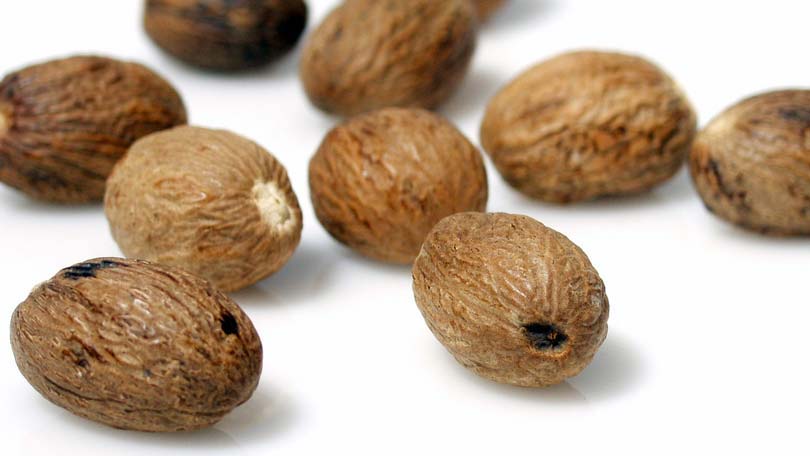
Nutmeg, or Myristica fragrans, is an evergreen tree in the Myristicaceae family. The tree actually produces two spices used in the culinary world: mace and nutmeg, nutmeg being the seed of the tree (which is found at the center of its fruit). The spice is native to Indonesia and the West Indies but is now cultivated in several other warm climates. It made its first historical appearance around the early 9th century as a seasoning in monasteries, and has gone on to become a valuable tool in a baker’s arsenal.
Characteristics
Nutmeg is the centered seed of the tree’s yellowish fruit which is the size of an apricot or nectarine. The fruit itself is edible; it is generally split, covered in palm sugar, and sweetened/fermented over the course of a few days before eating. When split the fruit reveals a protective layer (this layer is dried and sold as mace), the fruit flesh, and a smooth, shiny pit – the nutmeg is at the center of this pit. Nutmeg is ovate, around 1-2 inches long, and has a wrinkled brown surface. This spice is sold whole or ground and has a warm, nutty flavor. Its aroma is enticing and sweet, and is amplified when baked into treats or pastries.
The plant itself is a tropical tree which generally reaches around 30-40 feet in height. It has thick, strong branches with dense, grayish bark and dark-green oval leaves. It also buds small light-yellow flowers.
Common Uses
Nutmeg has long been a spice in high demand and hence was of great value to those who controlled it in the trade market. Historically it was the Arabs who first enjoyed control of the seed – this control shifted later to the Dutch. The Dutch tried to keep a lock on the market by closely monitoring the tree and its seeds, going as far as to destroy trees which naturally sprouted outside of their designated growing regions. These efforts ultimately failed, and nutmeg was later cultivated by the French and British respectively before the whole silly business of control eventually died down.
Nutmeg is utilized in many world cuisines, most notably Middle Eastern, English, and West Indian. Its aroma and flavor are particularly useful in baking sweet dishes such as pies, cakes, cookies, pastries, puddings, and custards. It can also work in savory dishes like cheese spreads, cheese sauces, dips, lentil dishes, soufflés, and soups with tomato or chicken bases. Nutmeg is a part of the Moroccan spice blend ras el hanout (nutmeg, cardamom, cassia, mace, clove, cumin, chili, rose petals, cinnamon, and almost a dozen more). It is known for its use in Italian sausages and in the Scottish dish haggis. Holiday drinks such as cider, mulled wine, and eggnog would not be the same without it either.
Nutmeg is poisonous in high does, and a teaspoon or less is usually more than enough in most recipes. Frequent use will not result in adverse affects or overdose – one would have to ingest a significant amount (more than half a pound) in a single sitting in order to require medical attention.
The spice has been used to treat digestive issues such as flatulence, indigestion, vomiting, nausea, and other such ailments. It has also been abused in the drug world as a way to obtain a narcotic high, though usually with little to no success.
Use and Storage
Nutmeg can be purchased whole or ground in most supermarkets. Whole nutmeg is preferred as ground loses its flavor more quickly, but requires a special grinder in order to process for cooking. Ground nutmeg should be stored in an airtight container out of direct sunlight.
Use It:
- to season Middle Eastern dishes
- in béchamel sauce
- in milk dishes like rice pudding, custards, or cream fillings
- to season pureed pumpkin or butternut squash
- to add flavor to spinach or potatoes
- sprinkled on grilled pineapple for a tropical dessert
- in cheese dishes or soufflés
- in baked goods like pastries or cakes
- when preparing Italian sausage or seasoned meat dishes
- to add dimension to seasoned cider or mulled wine
Recipe with Nutmeg
Virgin Eggnog (*note: recipe contains raw eggs)
4 eggs, beaten
6 tablespoons sugar
2 teaspoons vanilla
¼ teaspoon ground nutmeg
½ teaspoon cinnamon
4 cups whole milk
1/3 cup half and half
In a large bowl put beaten eggs, vanilla, and sugar. Combine. Stir in milk slowly. Stir in half and half slowly. Add cinnamon and nutmeg. Stir again to combine completely. Let chill for several hours before serving.
